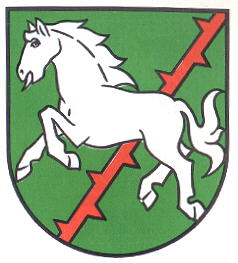Wennerode: Difference between revisions
Jump to navigation
Jump to search
Knorrepoes (talk | contribs) m (Text replacement - "/Arms of " to "/Arms (crest) of ") |
Knorrepoes (talk | contribs) m (Text replacement - "{{media}}" to " {{de1}} {{media1}}") |
||
| Line 25: | Line 25: | ||
The arms show a red piece of barbed wire, a symbol of the former border between East- and West-Germany, which was situated very close to the village. The green colour represents the fields and forests. The silver horse refers to the hamlet of Weisses Ross (white horse) in the former municipality. | The arms show a red piece of barbed wire, a symbol of the former border between East- and West-Germany, which was situated very close to the village. The green colour represents the fields and forests. The silver horse refers to the hamlet of Weisses Ross (white horse) in the former municipality. | ||
{{ | |||
{{de1}} | |||
{{media1}} | |||
[[Civic Heraldry Literature - Germany|'''Literature''']]: Rabbow, 1977 | [[Civic Heraldry Literature - Germany|'''Literature''']]: Rabbow, 1977 | ||
Revision as of 11:17, 26 December 2022
This page is part of the German heraldry portal |
Heraldry of the World |
|
German heraldry:
|
Selected collector's items from Germany:
|
WENNERODE
State : Niedersachsen
District (Kreis) : Goslar
Incorporated into : 1972 Vienenburg (2014 Goslar)
| German | |
| English | No blazon/translation known. Please click here to send your (heraldic !) blazon or translation |
Origin/meaning
The arms were officially granted on July 1, 1972.
The arms show a red piece of barbed wire, a symbol of the former border between East- and West-Germany, which was situated very close to the village. The green colour represents the fields and forests. The silver horse refers to the hamlet of Weisses Ross (white horse) in the former municipality.
Literature: Rabbow, 1977


